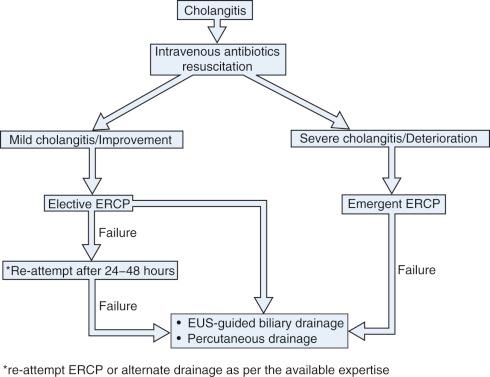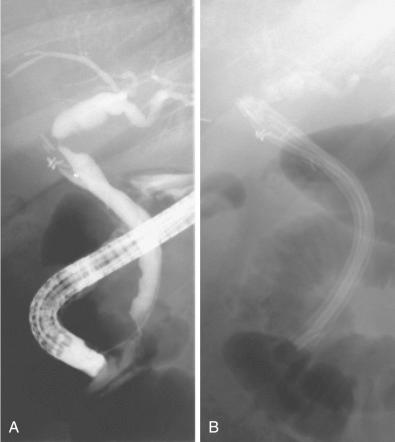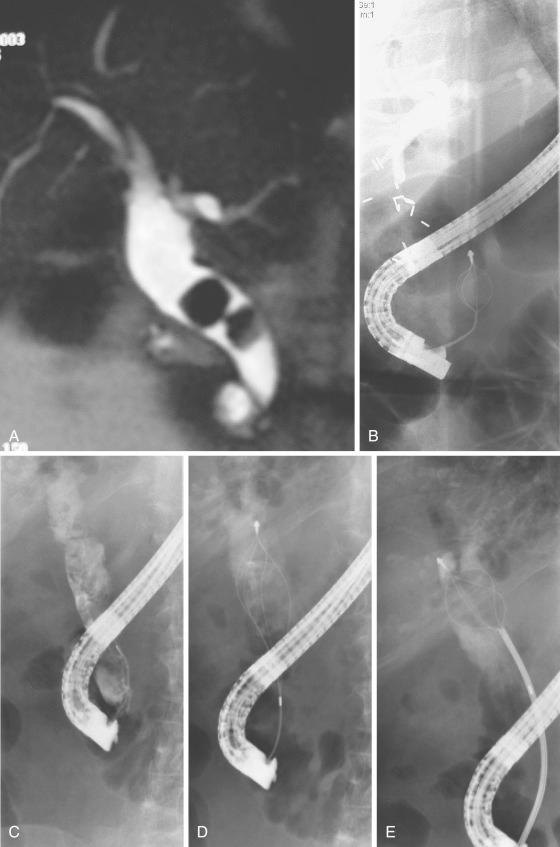Physical Address
304 North Cardinal St.
Dorchester Center, MA 02124
The word cholangitis is a pathologic term that means “inflammation of bile ducts.” It is a broad term and does not imply any specific diagnosis. In clinical practice, cholangitis is defined on the basis of symptoms and signs of systemic sepsis originating in the biliary tract.
The most important predisposing factor for infections of the biliary tract, including the common bile duct (CBD) and gallbladder, is obstruction to the flow of bile. By far, gallstones remain the most common cause of obstruction and infection of biliary tract (cystic duct or CBD). Other causes of cholangitis include biliary strictures (benign or malignant), recurrent pyogenic cholangitis (RPC), iatrogenic (post-endoscopic retrograde cholangiopancreatography [ERCP]), parasitic (Ascaris, liver flukes, echinococcal), viral (HIV cholangiopathy), etc. ( Box 55.1 ). In this chapter, we shall discuss biliary tract infections (cholangitis and cholecystitis) due to various etiologies and their management.
Choledocholithiasis and hepatolithiasis
Biliary stent occlusion
Mirizzi's syndrome
Biliary parasites
Fungal ball
Hemobilia
Sump syndrome
Choledochal cyst
Primary sclerosing cholangitis
Chronic pancreatitis
Pancreatic cyst or pseudocyst
Papillary stenosis
Recurrent pyogenic cholangitis
AIDS cholangiopathy
Ischemic stricture
Anastomotic stricture
Liver transplant
Bilioenteric anastomosis
Radiation
Postchemoinfusion
Tuberculosis
Cholangiocarcinoma
Pancreatic carcinoma
Ampullary adenoma or carcinoma
Duodenal carcinoma
Carcinoid tumor
Small intestinal lymphoma
Kaposi's sarcoma
Metastatic disease
Post-ERCP
Postsphincterotomy
Posthepatojejunostomy
Posttranshepatic cholangiography
Post–T-tube cholangiography
AIDS, acquired immunodeficiency syndrome; ERCP, endoscopic retrograde cholangiopancreatography.
The primary indication for ERCP in infectious cholangitis is to decompress the obstructed biliary system.
Contraindications to ERCP in biliary tract infections are similar to other endoscopic procedures. Patients who are unable to tolerate conscious sedation because of cardiopulmonary disease require an anesthesia assessment. The risk of adverse reaction to iodine containing contrast media is very low, and prophylactic premedication for contrast allergy is usually not required.
ERCP in pregnancy is apparently safe for both the mother and the fetus compared with the risk of delay in definitive treatment of cholangitis, which may be life-threatening.
Radiation to the fetus can be minimized by external shielding with a lead apron placed under the lower abdomen, limiting fluoroscopy time, collimating the beam to the area of interest, using brief “snapshots” of fluoroscopy, and avoiding hard copy x-ray films.
To perform ERCP, a side-viewing endoscope (duodenoscope) and fluoroscopy are required. Cannulation with a sphincterotome is recommended because most cases of biliary tract infection require a sphincterotomy. A guidewire is essential for selective cannulation of the intrahepatic ducts and the cystic duct and for accessing the biliary tree proximal to a stricture. To extract intraluminal debris, a biliary extraction basket and/or balloon must be available. Mechanical lithotripsy may be necessary before extraction of larger stones. Dilating catheters or a biliary dilation balloon, or both, and a selection of plastic and metal biliary stents are required to manage cholangitis secondary to a biliary stricture. A cytology brush and biopsy forceps are used to sample the stricture before stent insertion. Nasobiliary tubes are needed for biliary instillation therapy in certain forms of parasitic cholangitis. Duodenoscope-assisted cholangioscopy may be required to identify completely obstructed intrahepatic ducts, place a guidewire across a stricture, perform directed biopsies of a biliary stricture, and perform electrohydraulic lithotripsy (EHL) or laser lithotripsy (LL).
The patient should be kept nothing per mouth (NPO) after midnight the day before ERCP. In urgent situations this may not be possible. Coagulopathy should be corrected if possible. A decision to discontinue anticoagulants or antiplatelet agents should be individualized. There is insufficient evidence to support routine discontinuation of aspirin and nonsteroidal antiinflammatory drugs before therapeutic ERCP procedures. Antibiotics should be administered for prophylaxis of post-ERCP cholangitis if indicated, but patients with established cholangitis will already be receiving antibiotics.
If complete endoscopic drainage is not achieved during the initial procedure, antibiotics should be continued until definitive therapy is performed by repeat endoscopic, percutaneous, or surgical biliary decompression. Biliary obstruction resulting from hilar strictures and intrahepatic duct strictures, particularly multiple strictures as seen in sclerosing cholangitis, often require antibiotics after the procedure. Antibiotics, however, are not a substitute for adequate biliary drainage.
The duration of antimicrobial therapy for acute cholangitis is a subject of debate. As per the Tokyo guidelines, patients with moderate or severe acute cholangitis (see later sections in this chapter) should receive a minimum duration of antibiotics for 5 to 7 days. In patients with mild cholangitis or after successful endoscopic therapy, a duration of 2 to 3 days is sufficient.
Complications of ERCP include the complications inherent to any endoscopic procedure, including reactions to medications, cardiopulmonary complications, infection, perforation, hemorrhage, and complications specific to ERCP, such as pancreatitis, postsphincterotomy hemorrhage, and biliary infection. Infectious complications of ERCP are post-ERCP cholangitis and long-term postsphincterotomy cholangitis. However, delayed and unsuccessful ERCP are the two major factors associated with complications and worse outcomes in patients with acute cholangitis. Endoscopic sphincterotomy may be avoided in patients with acute severe cholangitis due to increased risk of bleeding.
ERCP is the mainstay of endoscopic drainage of the biliary tract. Asymptomatic bacteremia is common after diagnostic or therapeutic ERCPs. However, it is rarely significant clinically and routine antibiotic prophylaxis is not recommended after ERCP. Biliary tract infections after ERCP include acute cholangitis, acute cholecystitis, and cholangitic abscesses ( Table 55.1 ).
| Risk Factors | Mechanism | |
|---|---|---|
|
Complex hilar strictures, PSC, post liver transplant | Incomplete biliary drainage |
|
Contaminated duodenoscopes/accessories Faulty scope design |
Improper scope disinfection |
|
Immunocompromised patient | Impaired host defense |
The most important risk factor for acute cholangitis after ERCP continues to be incomplete drainage of an obstructed biliary system. ERCP in patients with complex hilar strictures (Bismuth type III/IV), post live donor liver transplant, and primary sclerosing cholangitis (PSC) are associated with higher risks of incomplete biliary drainage and subsequent cholangitis. Therefore, antibiotic prophylaxis should be considered in these situations.
Another important risk factor for post-ERCP sepsis is improper reprocessing of the endoscopes. Failure of adherence to the endoscope disinfection guidelines along with difficulty in cleaning the elevator of the duodenoscope has resulted in recent outbreaks of multidrug resistant organisms like E. coli, Klebsiella, and pseudomonas . Therefore, newly designed endoscopes should be subjected to strict premarketing validation of the reprocess ability and post-marketing surveillance.
Acute cholecystitis may occur in 1.9% to 12% of patients after ERCP. It is usually associated with metal stent placement for malignant biliary obstructions. Obstruction of the cystic duct orifice by the stent, tumor involvement of the cystic duct, and introduction of nonsterile bile or contrast agent are the proposed factors that predispose to acute cholecystitis in these patients.
Iatrogenic cholangitis after ERCP should be prevented when possible. Delineation of biliary anatomy with prior magnetic resonance cholangiopancreatography (MRCP) will provide an anatomical road map for ERCP. Prophylactic antibiotics should be used in patients at high risk of incomplete biliary drainage. Contrast agents must not be instilled into obstructed segments prior to securing a guide wire beyond obstruction. The use of air cholangiogram is an attractive strategy to prevent cholangitis in hilar strictures and deserves further evaluation in randomized trials.
In the case of incomplete drainage, biliary drainage with an alternate modality (percutaneous, endoscopic ultrasound [EUS]-guided, or surgical) should be promptly carried out to avoid morbidity and mortality. Adequate reprocessing of duodenoscopes and strict adherence to the guidelines for disinfection are mandatory.
Acute cholangitis is a clinical syndrome defined by the triad of right upper quadrant pain, fever, and jaundice (Charcot's triad). The presence of altered sensorium and hypotension in addition defines Reynold's pentad. Although the presence of this pentad is uncommon, it portends a poor prognosis in these patients. The basic predisposing factors of cholangitis include stasis (due to biliary obstruction) and disruption of the anatomical barrier (i.e., sphincter of Oddi) due to previous surgery, sphincterotomy, or placement of biliary endoprostheses. This leads to bacterial infection of the biliary tract. Infected bile with elevated intrabiliary pressure, exceeding the cholangiovenous reflux pressure leads to translocation of bacteria into systemic circulation, eventually leading to sepsis. Choledocholithiasis, biliary strictures, and previous biliary instrumentation are relatively common causes of cholangitis (see Box 55.1 ). In contrast, cholangitis is relatively uncommon in malignant biliary strictures due to complete obstruction, which limits the chances of ascending infection.
The Tokyo guidelines for the diagnosis and management of acute cholangitis were initially published in 2007 and updated in 2013. The diagnosis of cholangitis is based on the presence of systemic inflammation (clinical, laboratory data), cholestasis (abnormal liver function tests), and imaging (biliary dilatation/stone/stricture, etc.). Ultrasonography is a reasonable initial imaging modality in patients with suspected acute cholangitis. The sensitivity of ultrasonography is only 50% for detection of CBD stones due to the proximity of the duodenum and interference with bowel gas. In the authors unit, EUS or MRCP is performed prior to ERCP if the clinical suspicion of cholangitis is not strong. Unnecessary ERCPs and associated complications can be avoided with this approach. Moreover, MRCP can provide an anatomical road map for subsequent ERCP, which may be especially useful in the case of hilar or intrahepatic obstruction. However, ERCP is performed without delay in cases of strong suspicion of severe cholangitis based on clinical and laboratory features.
Three grades of severity of cholangitis in the Tokyo guidelines are based on the presence or absence of organ dysfunction, age, and laboratory parameters (white blood cell count, bilirubin level, serum albumin). In moderately severe cholangitis, at least two of the following conditions are present: abnormal leucocyte count (> 12,000/mm 3 or < 4000/mm 3 ), fever (≥ 39°C), age (> 75 years old), high bilirubin (> 5 mg/dL), and low albumin (< 0.7 × lower limit of normal). Presence of at least one organ dysfunction defines severe cholangitis.
Irrespective of the underlying etiology of cholangitis, the mainstay of management is drainage of the infected biliary system. However, initial stabilization of the patient is of paramount importance before any therapeutic intervention is contemplated. Intravenous antibiotics should be administered as per the local antimicrobial sensitivity trends. Antibiotic coverage against anaerobes should be considered in cases with prior history of bilioenteric surgery.
The modalities of drainage include endoscopic (ERCP and EUS-guided), percutaneous, and surgical. Initial medical treatment may be sufficient for patients with mild cholangitis, whereas urgent biliary drainage is indicated for those with moderate or severe cholangitis (organ dysfunction/elderly) ( Fig. 55.1 ).

Endoscopic biliary drainage is the preferred modality in most patients. ERCP may be performed with a palliative intent initially in patients with severe cholangitis. After resolution of cholangitis, a more definitive ERCP can be performed. Initial aspiration of infected bile under pressure before instilling contrast in the bile duct is a wise practice, and repeated injections of contrast into the bile duct should be avoided. Excessive injection of contrast into an obstructed biliary system may further increase the intrabiliary pressure leading to cholangiovenous reflux and aggravation of sepsis. The aspirated bile may be sent for culture and sensitivity. In the author's unit, a nasobiliary tube (NBT) is placed initially to drain the infected bile. In the subsequent days, a cholangiogram is obtained and definitive ERCP is carried out. Plastic biliary stents may also be used instead of NBT to avoid discomfort to the patient. Both approaches are equally effective in relieving acute cholangitis. Initial stent placement may also be accomplished in experienced hands in the intensive care unit setting without fluoroscopy in those patients too sick for transport.
In the following section, we shall discuss the endoscopic management of acute cholangitis caused by different etiologies.
Various surgical procedures which are potentially associated with postoperative cholangitis include postcholecystectomy bile duct injury, hepatojejunostomy, post liver transplant biliary strictures, afferent limb syndrome, and choledochoduodenostomy (sump syndrome).
The endoscopic management of postoperative benign biliary strictures includes either serial placement of multiple plastic stents or a fully covered metal stent for optimal results ( Fig. 55.2 ). Balloon or catheter dilatation may be required to facilitate stent placement. In a multicenter randomized trial, the stricture resolution was higher with covered metal stents as compared to multiple plastic stents (92.6% vs. 85.4%).

In afferent limb syndrome, long-standing afferent loop obstruction (stricture, kinking, or adhesions) results in pancreaticobiliary obstruction and may present as obstructive jaundice, cholangitis, or liver abscess. It usually occurs after subtotal gastrectomies, Billroth II surgeries, or other gastrojejunotomies. The management options include endoscopic, surgical, and percutaneous. Endoscopic treatment includes balloon dilatation and stenting across the afferent loop stricture. Limited data suggests that endoscopic management is safe and effective in these patients.
Sump syndrome is an uncommon entity that occurs after creation of choledochoduodenostomy to manage retained CBD stones in a dilated bile duct. The distal bile duct between the papilla and the anastomosis becomes a stagnant reservoir or sump into which sludge, calculi, and food can accumulate. The clinical presentation includes recurrent pain, cholangitis, hepatic abscess, or pancreatitis. Management with endoscopic sphincterotomy (ES) and extraction of debris from the bile duct is successful in most patients. However, a repeat sphincterotomy may be required in some cases due to restenosis of the sphincter.
ERCP may be difficult in patients with bilioenteric strictures like hepatojejunostomy ( Fig. 55.3 ). Treatment options include balloon enteroscopy–assisted ERCP, EUS-guided biliary drainage, and percutaneous biliary drainage.

Chronic pancreatitis related biliary strictures are often resistant to standard endoscopic management. However, stricture resolution of up to 90% has been reported with multiple plastic stents or covered metal stents. Therefore, endoscopic treatment should be the preferred initial treatment in such patients and surgery should be reserved for refractory cases.
Malignant biliary strictures are usually not associated with cholangitis unless previous instrumentation has been done. If present, cholangitis is a definite indication for preoperative biliary drainage in these patients. Metal stents provide superior results and are preferred over plastic stents irrespective of the resectability status.
In hilar strictures (Type III), bilateral stenting should be done (Y or parallel) with the goal of draining greater than 50% of liver volume. In patients with duodenal narrowing due to tumor infiltration or altered anatomy, EUS-guided biliary drainage is often successful.
Become a Clinical Tree membership for Full access and enjoy Unlimited articles
If you are a member. Log in here